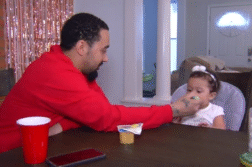SAN ANTONIO, Texas (Ivanhoe Newswire) – We all know how important breast self-exams are for women, but did you know testicle self-exams can be a lifesaver for men? In fact, testicular cancer is the most common cancer found in young men ages 15 to 30 years old. Almost 10,000 will be diagnosed with it this year. The first sign is a lump, often found during a self-exam. That lump can be cancer, which can spread to the abdomen and cause lymph nodes to enlarge and attach themselves dangerously to major vessels. Now, there’s a less invasive way to remove those cancerous lymph nodes and help young men become cancer-free.
Antonio Flores loves everything about cars. “My dream car will be like a Porsche but my dream car right now, I bought it already,” Antonio exclaims.
Even during chemotherapy treatments, Antonio spent days working on his cars.
He says, “You get moving, you get going, and you learn about how fascinating people can make something just with metal and a few bolts.”
So, when he was told he had testicular cancer, he just wanted it fixed. Antonio wanted whatever treatment that got him back to work the quickest.
Doctors decided to remove Antonio’s testicle and after weeks of chemo, they found more cancer in his lymph nodes.
“Chemotherapy makes the lymph nodes more stuck to the vessels and more difficult to remove,” surgeon and urologist at the Mays Cancer Center of UT Health San Antonio, Dr. Ahmed Mansour, explains.
Dr. Mansour is one of the few surgeons using a less invasive, more precise robotic surgery to remove the lymph nodes without harming the major blood vessels.
Instead of an incision running the length of Antonio’s torso, Dr. Mansour has adapted robotic surgery, using five small half-inch incisions to remove the lymph nodes.
“After everything was removed, the big lymph node is no longer there,” Dr. Mansour demonstrates to Ivanhoe.
The less invasive operation means less chance of infection, less blood loss, less pain – cutting hospital stays down to two days, and recovery to two weeks.
Antonio is cancer free and focused on getting married at Disney to the young lady who rode shotgun through it all.
Doctors recommend that men ages 15 to 55 perform a monthly self-examination to find any changes.
Contributors to this news report include: Marsha Lewis, Producer; Roque Correa, Videographer, Editor.
To receive a free weekly e-mail on medical breakthroughs from Ivanhoe, sign up at: http://www.ivanhoe.com/ftk
Source:
https://www.cancer.org/cancer/testicular-cancer/about/key-statistics.html
MEDICAL BREAKTHROUGHS
RESEARCH SUMMARY
TOPIC: STOPPING THE SPREAD OF TESTICULAR CANCER
REPORT: MB #5058
BACKGROUND: Testicular cancer, cancer of the testis, occurs when cancer cells form in one or both testicles. These cells begin to change and grow uncontrollably, forming a mass or tumor. The cells can also invade the blood stream and lymph system and spread, leading to tumors in other areas of the body called metastases. Most often testicular cancer is detected as a painless lump in one of the testicles. Testicular cancer is highly treatable and one of the most curable forms of cancer. Self-exams, starting in the adolescent years, are key in early detection of testicular cancer.
DIAGNOSING: Men themselves, not doctors, find most testicular cancers as a painless lump or an enlargement or hardening of the testicle, which is why regular self-exams are so important. If you do notice any lumps or changes it is important to see a doctor immediately. Many men with testicular cancer do not feel ill and many times there is no pain involved. Signs of testicular cancer include but are not limited to any enlargement of a testicle, a significant loss of size in one of the testicles, a feeling of heaviness in the scrotum, a dull ache in the lower abdomen, back or in the groin, a sudden collection of fluid in the scrotum, pain or discomfort in a testicle or in the scrotum, enlargement or tenderness of the breasts
NEW TECHNOLOGY: Ahmed Mansour, MD, Surgeon & Urologist at
UT Health San Antonio, Mays Cancer Center says a new robotic surgery has allowed for some technical modifications in the port placement where doctors can put their ports and where they can orient double bot. This surgery came also with a newer generation of robots which have higher flexibility of their arms, allowing them the ability to reach different areas. With these kinds of changes, together with the advancement in the robotic systems, doctors like Mansour can do the same job that they would do in open surgery. This provides advantages like less pain, less blood loss and faster recovery with the same oncologic outcomes as open surgery.
(Source: Ahmed Mansour, MD)
FOR MORE INFORMATION ON THIS REPORT, PLEASE CONTACT:
Will Sansom
If this story or any other Ivanhoe story has impacted your life or prompted you or someone you know to seek or change treatments, please let us know by contacting Marjorie Bekaert Thomas at mthomas@ivanhoe.com




